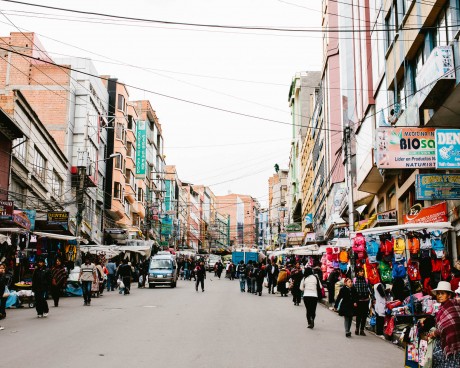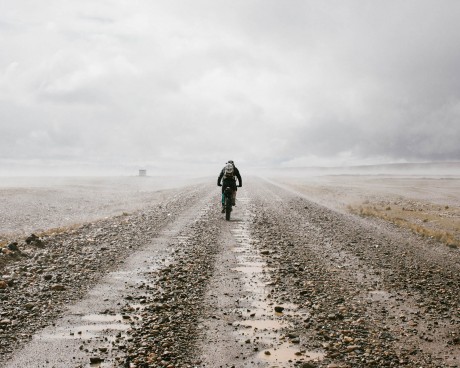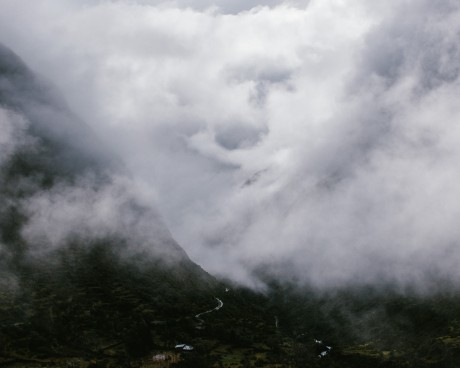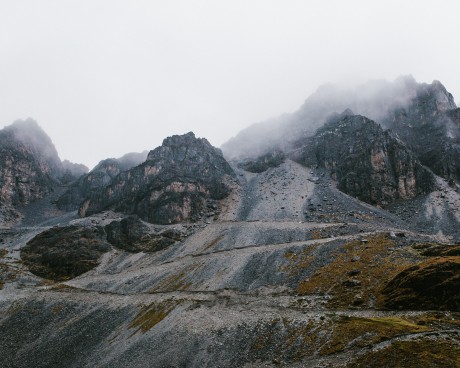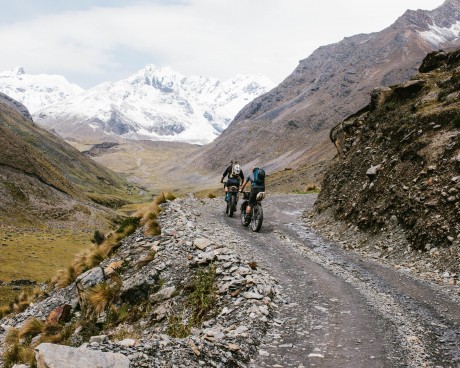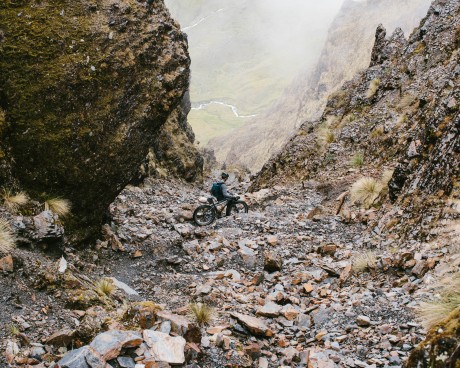
Sunchuli Pass: Day Two
SECTION No1
FYI - Addendum One Basic/Assorted Tips
- Plan on having two charges for everything. The agreed upon up front first charge and the surprise, after the fact, bonus charge that is tacked on because you are a tourist.
- Bolivia is majority Catholic country. Be prepared to have everyone look through the photos on your phone. Scrub images from your library before your arrival or expect to have to use your second grade level Spanish to try and explain why you have huge amount of morally questionable selfies and non-selfies.
- The orange piles of flesh being carried around in paint buckets are plucked chickens. We think.
- SERNAP is the real deal. According to Edgar, travelers can stay in any of their offices/outposts/stations for free. Hut to Hut style. However they don’t have online booking, it’s a stumble up to the front door and knock kinda deal.
- Most drivers on the Bolivian Altiplano are pretty cool, give you lots of room, and slow down. Except for this one little punk in a white Ford Fiesta, he will swerve towards you at high speed and spray a tidal wave of brown mud/turd/trash water all over you.
SECTION No2
Campameto Hichocollo - SERNAP Hospitality 14,469 ft
SECTION No3
The Ferocious Teens of Antaquilla 14,950 ft.
SECTION No4
Approach to Pelechuco Pass 15,000 ft. +
SECTION No5
Pelechuco Pass 16,010 ft.
I was just riding along when out of nowhere it hit me like a whippit. The sensation was like… you ever huff paint? Anyway, the road was the same road we’d been on for the last two days. Sure, yeah, we’d been gradually climbing but not really and besides today was supposed to be an easy day. A warm-up. Sunchuli Pass, two days from now, that was the Motherfucker.
Three months ago, when we finally decided on Bolivia because Colombia was going to be too wet and Argentina was going to be too boring, and because Bolivia had this mining problem, a byproduct of which is a vast network of physics-defying roads, I thought about the elevation. I think I remember saying something at the time like, “Hey guys those mountains are tall, like really tall.” And that was that until two weeks ago, when we really started planning and packing for Bolivia I thought about it and talked about it some more.
I even did some research, the gist of which was that if you can avoid getting altitude sickness you should because it’s uncomfortable and possibly deadly.”- DWP;Like with everything (car washes, diseases, insurance plans, burritos, etc.) there are levels. The first level, your basic run of the mill hypobaropathy or soroche, just causes fatigue, dizziness, lightheadedness, insomnia, tingles, jingles, shortness of breath, drowsiness, General Malaise11What a great name!!!! For like a G.I. Joe character or something!, nosebleeds, rapid pulse, and “excessive” farts. The next level is more dangerous. So dangerous in fact that several of the more common conditions have acronyms, e.g HAPE (high altitude pulmonary edema) and HACE (high altitude cerebral edema). I didn’t do a lot of research though because after reading all about the symptoms and causes of altitude sickness I came to the prevention section and it was empty. It basically said, “Don’t suck.” Apparently the best way to prevent and/or avoid altitude sickness was to be genetically superior. Also, just like allergies, altitude sickness can come and go, and come right back. Oh, and one last thing, there is no way to predict the effects on you, at any particular time or age. It just be what it be. Maybe you get HAPEed, maybe you don’t.
In fact the only thing you can do to mitigate the effects is to ascend to higher elevations gradually, in stages. So like, the only real advice the internet has is… walk up or drive up but definitely don’t fly up. And but because El Alto International Airport is located 13,799 feet above sea level,
- We didn’t land so much as “dock.” It’s almost like we took off from Miami, climbed to our flying altitude, went south towards a big mountain with a tarmac on top, and pulled into the tarmac much like a car pulls into driveway—it just makes a turn and stops.
- We did not ascend to higher elevations gradually. We did the opposite. Basically we strapped ourselves to a rocket and rode it to space.
You land, you taxi, you come to a stop and the plane powers off. The second the plane is all the way off and the pressurized cabin is no longer pressurized, you’re fucked. Instantaneously you feel 70% heavier, dumber and slower. And gassier. But then you descend to La Paz and you walk around, and you get your bearings, and 24 hours goes by and you normalize. Your new normal kinda sucks, like having a hangover and the bends at the same time. But other than that, and the insomnia, you’re good to go. At least physically and mentally.
Emotionally though, elevation was a constant consideration. Especially because all we did was go places and make plans to go to other more places.”- DWP;Everyday, all day long, every chance we had, we asked locals:
- How high is that pass?
- Is this pass higher than that pass?
- What elevation is this town at?
- What elevation are we at now?
And we talked among ourselves:
- Did you sleep last night?
- Is Charazani higher than La Paz?
- What elevation did we sleep at last night?
- What elevation are we sleeping at tomorrow night?
- How tall is Sunchuli?
- Is Sunchuli the tallest pass?
- What’s the average elevation of the Altiplano?
- Did you just fart?
Anxiety and preoccupation aside, and except of course for the constant low-grade feeling of mailasment, so far, the last two days were a lot like bikepacking. Sure, yesterday we rode for seven hours across the Altiplano in the kind of weather one associates with Jupiter. And we did come upon way more towns than expected. And were surrounded by more Turds, Trash and Mud than expected. But there were roads, and people and mountains and all of our shit was strapped to our bikes soo…
Then about 2k from the top of Pelechuco Pass it hit me. I was just riding along when suddenly I felt dizzy and confused, and I just kinda fell off my bike a little bit. Also, my heart was beating unreasonably fast.”- DWP;So I spit out my coca leaf and started push-walking my bike instead of riding it. Figuring that maybe what happened was I suck at riding my bike over 15,000 foot mountains. Then it started snowing, and the headwind which had been gnarly for the last thirty minutes started throwing rocks and sand, and icicles, at my face. That’s when I realized I was preternaturally hungry. And out of water. Also, it’s at about that time the first of many nearly-debilitating anxiety attacks attacked me.
Just to be clear:
- We were in a blizzard.
- We were 15,000 feet above sea level and climbing.
- I was super-duper hungry.
- And I was confused, dizzy and suffering from disorganized thinking.
- And I was in the midst of a pretty wicked anxiety attack.
- And I was panting.
- And the temperature was dropping.
- Oh, and at this point we were FULLY committed. Turning around wasn’t really an option and the fastest way down—and I needed to go down, immediately—was straight ahead.
Which speaking of which, all mountaintops are by definition slow to come. That’s what mountaintops do, they dole themselves out slooooooooowwwwwwwlly. If you want to get over them you have to haul them in, like a trophy marlin. Using, in my case, an eight year old child’s arms. But this fucking thing was ridiculous. I felt like Frodo, if Frodo had to deliver a highly specialized mountain bike instead of throw away a piece of dangerous jewelry. One step at a time. For what felt like hours. In a fucking whiteout. I would have taken photographs but at the time I seriously thought I was going to
- die.
- go crazy.
- start crying.
- freeze to death.
- pass out.
- never see my kids again.
So I didn’t take any photographs. I just mumbled and stumbled my way past the lake, to the cross built into the rock wall marking the summit, then down the other side. I’ll leave you with these three thoughts:
- I have a running tally (in my brain mind) of the photographs that “got away.” This is a very special list for very special photographs. I go for weeks and months and even years without adding to this list. And sometimes when the light is right I might add two moments to the list in just one afternoon. The shit I saw on that mountaintop. The blizzard light at 15,000 feet. I missed no fewer than five photographs that afternoon. Maybe more.
- I NEVER WOULD HAVE MADE IT OVER THAT FUCKER without Kyle and James. The physical/mental/emotional/spiritual assistance I required was pretty fucking serious. Also, I’m sure those fuckers were taxed as well. Or maybe not. Whatever. I’m alive because of them.
- The road down the backside of Pelechuco Pass is the most remarkable and spectacular road in the world. I stake my life on it. That I was frozen and in no state to enjoy myself, on what was/is/and forever will be the wickedest descent ever, is tragic.
SECTION No6
Pelechuco 11,787 ft.
DILLON MAXWELL EARNED A BA IN HISTORY FROM COLORADO STATE UNIVERSITY. HE WROTE HIS THESIS ON THE SPANISH CIVIL WAR'S EFFECTS ON THE CUBAN REVOLUTION AND DID HISTORICAL FIELDWORK IN SOUTHERN COLORADO FOCUSING ON FAMED AMERICAN EXPLORER ZEBULON PIKE AND THE ENVIRONMENT PIKE ENCOUNTERED IN HIS TRAVELS. DILLON LIVES IN FORT COLLINS, COLORADO WHERE HE SPENDS HIS TIME RIDING BIKES, CAMPING, RIFFIN', AND PLAYING DRUMS. Brief Histories: Pelechuco by Dillon Maxwell
Nestled in the heart of the Cordillera Apolobamba is the small town of Pelechuco. The name comes from the Quechua Phuyu Kuchu, meaning “cloudy corner.” Pelechuco is an exemplar of how globalization can reach into unseemingly far off places. The town has not been spared from the ravages of exploration, colonialism, and adventure perpetrated by those from faraway lands.
The area was originally inhabited by the Mollo peoples and later by the Incans. Though no large scale settlements were set up in the present day area, small scale archeological sites can be found outside of Pelechuco.
The town of Pelechuco itself was founded in the 1560’s by Jesuit Priests. The Spanish used the town because it sits at a crossroads for travelers and traders in the area. The cultural landscape of Pelechuco reflects this Spanish influence. An old Catholic Church made of stone, a town square, and cobble streets dominate much of the cultural landscape. For 300 plus years, the small town experienced a cultural syncretism, blending Aymara, Quechua, and Spanish influence.
Another culture got thrown into the mix in the early 1900s when a German mining mogul, Karl Francke, made his way to Pelchuco. Francke was part of the Aramayo-Francke Mining Company, Bolivo-Germanic mining venture specializing in tin, gold, and wolfram. The company was based in England, then moved to Geneva to dodge a lofty British tax imposition. In the town’s square, Franck added a wrought-iron fountain in the town’s square and large stone house, in which Francke resided. Leading one to wonder if Francke used the tax money he saved from dodging British tax to set up his residence and town square in Pelechuco in order to create his lasting legacy on the town.
Francke has also been tied to the famed British adventurer, archeologist, and explorer, Colonel Percy Fawcett. Fawcett’s fame comes from his exploration of Latin America in search for the “Lost City of Z,” in addition to his survey work of the Brazilian-Bolivian border. Fawcett is documented as staying in the Pelechuco on several occasions with Francke hosting him and his expedition.

 PROJ Y Casting
PROJ Y Casting  PROJ Y WOF
PROJ Y WOF  Lunar Bikepacking
Lunar Bikepacking  Prospectus
Prospectus  The Dead Reckoning Book
The Dead Reckoning Book  starter pack
starter pack  Bikepacking 101
Bikepacking 101  Dead Reck is Dead
Dead Reck is Dead  Introduction
Introduction  Day 01
Day 01  Day 02
Day 02  Introduction
Introduction  Day 01
Day 01  Day 02
Day 02  Day 03
Day 03  Introduction
Introduction  Day 01
Day 01  Day 02
Day 02  Day 03
Day 03  Day 04
Day 04  Day 05
Day 05  Day 06
Day 06  Introduction
Introduction  Day 01
Day 01  Day 02
Day 02  Day 03
Day 03  Day 04
Day 04  Introduction
Introduction  Day 01
Day 01  Day 02
Day 02  Day 03
Day 03  Introduction
Introduction  Day 01
Day 01  Day 02
Day 02  Day 03
Day 03  Introduction
Introduction  Day 00
Day 00  Day 01
Day 01  Day 02
Day 02  Day 03
Day 03  Day 04
Day 04  Instagram Symposium
Instagram Symposium  Introduction
Introduction  Day 00
Day 00  Day 01
Day 01  Day 02
Day 02  Day 03
Day 03  Day 04
Day 04  Day 05
Day 05  Day 06
Day 06  Day 07
Day 07  Introduction
Introduction  Day 00
Day 00  Days 01-02
Days 01-02  Day 03
Day 03  Day 04
Day 04  Day 05
Day 05  Day 06
Day 06  Days 07-08
Days 07-08  Day 09
Day 09  Lord Nerd Beta
Lord Nerd Beta  Base Camp: Motel on Carroll, Dunedin
Base Camp: Motel on Carroll, Dunedin  Day 01: Dunedin to Danseys Inn
Day 01: Dunedin to Danseys Inn  Day 02: Danseys Pass to Ida Railway Hut
Day 02: Danseys Pass to Ida Railway Hut  Day 03: Ida Railway Hut to Omarama Pass
Day 03: Ida Railway Hut to Omarama Pass  Day 04: Omarama to Huxley Forks
Day 04: Omarama to Huxley Forks  Day 05: Huxely Forks to Brodrick Pass
Day 05: Huxely Forks to Brodrick Pass  Day 06: Brodrick Pass to Wanaka
Day 06: Brodrick Pass to Wanaka  Lord Nerd Beta
Lord Nerd Beta  Preface
Preface  Day 01: Charazani to Hichocollo
Day 01: Charazani to Hichocollo  Day 02: Hichocollo to Pelechuco
Day 02: Hichocollo to Pelechuco  Day 03: Pelechuco to Mountainside Bivouac #1
Day 03: Pelechuco to Mountainside Bivouac #1  Day 04: Mountainside Bivouac #1 to Hilo Hilo
Day 04: Mountainside Bivouac #1 to Hilo Hilo  Day 05: Hilo Hilo to Mountainside Bivouac #2
Day 05: Hilo Hilo to Mountainside Bivouac #2  Day 06: Mountainside Bivouac #2 to Curva
Day 06: Mountainside Bivouac #2 to Curva  Outro
Outro  Lord Nerd Beta
Lord Nerd Beta  Day 01: Oasis to Bishop
Day 01: Oasis to Bishop  Day 02: Bishop to North Lake
Day 02: Bishop to North Lake  Day 03: North Lake to Piute Pass and Back to Piute Lake
Day 03: North Lake to Piute Pass and Back to Piute Lake  Day 04: Piute Lake to Bishop
Day 04: Piute Lake to Bishop  Day 05: Mono Hot Springs
Day 05: Mono Hot Springs  Lord Nerd Beta
Lord Nerd Beta  Day 00: The Approach
Day 00: The Approach  Day 01: Tyax Lodge to Iron Pass
Day 01: Tyax Lodge to Iron Pass  Day 02: Iron Pass to Graveyard Valley
Day 02: Iron Pass to Graveyard Valley  Day 03: Graveyard Valley to Trigger Lake
Day 03: Graveyard Valley to Trigger Lake  Day 04: Trigger Lake to Tyax Lodge
Day 04: Trigger Lake to Tyax Lodge  Flooded with Feeling
Flooded with Feeling  Wilderness
Wilderness  Mike Cherney on Black Bears
Mike Cherney on Black Bears  Rope Swing
Rope Swing  Slash Piles
Slash Piles  Nylon
Nylon  Conversations with a Black Bear
Conversations with a Black Bear  US Route 93
US Route 93  Turnagain Mud Flats
Turnagain Mud Flats  Bushwhacking in British Columbia
Bushwhacking in British Columbia  Men’s Penury
Men’s Penury  Bob Dittler et. al.
Bob Dittler et. al.  Bushwhacking in the MSOJ
Bushwhacking in the MSOJ  Mike Cherney’s Knife
Mike Cherney’s Knife  Hideout, UT
Hideout, UT  Hoover Dam
Hoover Dam  Shoe Tree
Shoe Tree  Destruction
Destruction  The Siskiyou Mountain Club
The Siskiyou Mountain Club  Coral Pink Sand Dunes State Park
Coral Pink Sand Dunes State Park  EN 417 – Normes Européennes 417 – The Lindal Valve
EN 417 – Normes Européennes 417 – The Lindal Valve  Wolf Satellite
Wolf Satellite  Itchy and Scratchy
Itchy and Scratchy  Tanoak Dust
Tanoak Dust  Lake Havasu
Lake Havasu  Knife Fighting
Knife Fighting  The Comfort Inn Covenant
The Comfort Inn Covenant  The Wrong/Right Way To Experience Montauk
The Wrong/Right Way To Experience Montauk  Ohiopyle Falls
Ohiopyle Falls  Allosaurus via Lean-to
Allosaurus via Lean-to  Lyle Ruterbories, Glacier National Park Ranger
Lyle Ruterbories, Glacier National Park Ranger  Water Interface Experimentation (WIE)
Water Interface Experimentation (WIE)  OSOs & UOSOs e.g., Mt. Oberlin
OSOs & UOSOs e.g., Mt. Oberlin  Louisiana Custom Cars
Louisiana Custom Cars  Archaeologizing, Pt. II
Archaeologizing, Pt. II  Archaeologizing, Pt. I
Archaeologizing, Pt. I  Mather Point
Mather Point  Sarah Plummer Lemmon & Matt Hall
Sarah Plummer Lemmon & Matt Hall  Kangaroo Lake and Fran
Kangaroo Lake and Fran  Minor Religions of the Mt. Shasta Region
Minor Religions of the Mt. Shasta Region  The Fist Bump
The Fist Bump  The Ideal Shelter
The Ideal Shelter  Headwaters of the Sacramento River
Headwaters of the Sacramento River  Buckle Bunnies
Buckle Bunnies  DFKWA: Baldface Creek - Part I
DFKWA: Baldface Creek - Part I  Mule Deer Radio Collaring
Mule Deer Radio Collaring  The Disappearance of Everett Ruess
The Disappearance of Everett Ruess  Dall Sheep Kebabs
Dall Sheep Kebabs  The Ideal Woodsman Knife
The Ideal Woodsman Knife  DFKWA: Rough and Ready Creek - Part I
DFKWA: Rough and Ready Creek - Part I  Rowdy Water
Rowdy Water  Killing a Mountain Caribou
Killing a Mountain Caribou  Boredom, Slingshots, and Prairie Dogs
Boredom, Slingshots, and Prairie Dogs  We Would Like to Visit
We Would Like to Visit  Black Bear Ranch
Black Bear Ranch  Origins
Origins  The Heart of the Klamath
The Heart of the Klamath  Skid Town Bicycles
Skid Town Bicycles  Low Stress Management
Low Stress Management  CLUB MACHO
CLUB MACHO  Club Macho Ep. 01
Club Macho Ep. 01  Club Macho Ep. 02
Club Macho Ep. 02  Club Macho Ep. 03
Club Macho Ep. 03  Cumberland Permanent
Cumberland Permanent  Iron Goat Permanent
Iron Goat Permanent  Natchez Trace Permanent
Natchez Trace Permanent  Trail of Tears Permanent
Trail of Tears Permanent  (Dis)Enchanted Rock Permanent
(Dis)Enchanted Rock Permanent  MSOJ Permanent
MSOJ Permanent  Shorty Peak Lookout
Shorty Peak Lookout  Deer Ridge Lookout
Deer Ridge Lookout  Arid Peak Lookout
Arid Peak Lookout  Flag Point Lookout
Flag Point Lookout  Umpqua Hot Springs
Umpqua Hot Springs  Cougar Hot Springs
Cougar Hot Springs  Bagby Hot Springs
Bagby Hot Springs  Goldbug Hot Springs
Goldbug Hot Springs  Ft. Bridger Rendezvous
Ft. Bridger Rendezvous  Corndoggin’ Castle Lake
Corndoggin’ Castle Lake  Kangaroo Lake
Kangaroo Lake  The Narrows
The Narrows  Matthews Creek
Matthews Creek  Introduction
Introduction 


